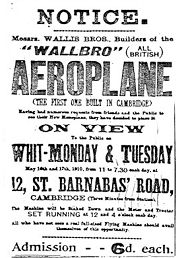Our Territories
Channel Islands
England
Ireland
Isle of Man
Scotland
Wales
Our Categories
HORACE & PERCY WALLIS
John Wallis of Rangles Farm in March, Isle of Ely was born in 1827. In 1850 he married Mary Johnson, a widow with three children. They had two boys, John born in1851 and Samuel Banks, born in 1855. Samuel married Rebecca King from High Bow in London and they set up their home at 12, St. Barnabas Road, in Cambridge. Samuel had a successful Grocers and Tea Importers business in Cambridge. They had six children, Victor, their eldest was born in 1877, Horace was born in 1883, Percy Valentine born in 1885, Garnett born in 1887 and Beatrice born in1886. & Kate
Horace, and Percy his younger brother started motor cycle racing and by the turn of the century were making their own motor cycles they set up the “Walbro” Cycle and motor works They must have decided to branch into aircraft about 1908 and started building their “Walbro” Monoplane. Being familiar with the fabrication of motor cycle frames using steel tube they must have decided that this material for all the frames of their monoplane. This was a spare-time project even though they named the project The “Wallbro” Aeroplane Co Cambridge. Their Office and works was at their. Parent’s home.
 |
In St. Barnabas Road and they gave their aircraft project was to be the first ‘All British Aeroplane’. The two boys started work on what they hoped would be the lightest but strongest monoplane in Cambridge. The aircraft was assembled in a shed at the back of their parent’s house. The brothers designed their flying machine to embody a number of new ideas. The design followed the ideas used by Bleriot and Antoinette monoplanes yet it differed from both these machines in several important ways. One such variation was the framework. |
| The brothers were strong believers in the strength of steel tubing. The fuselage used mainly one-inch diameter tube of 20 gauge, arranged on the girder principle, strongly braced with steel wire. The cross tubing were double bolted onto steel lugs similar to those used in motor cycle construction. The wire stays were attached to eyebolts passing through these lugs. Tightening of the wires was accomplished by means of bronze tensioning screws, which have right and left-hand screw threads. These ideas together with a multitude of others succeeded in producing a machine, which was both light and very strong.. The fuselage was twenty-five feet long with a wing span of thirty feet. The undercarriage was also of tubular design but used heavier gauge tubing. The strong yet | |